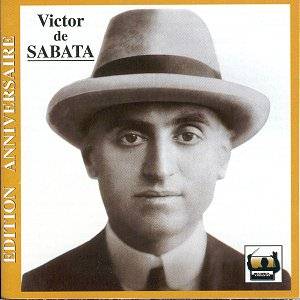Tahra’s anniversary Edition sleeve-notes maintain that
‘If the emotion is there, then the music comes alive. It’s no longer
just another antiseptic product’. Fine words, but ones which have little
of relevance to Victor de Sabata’s ramrod-straight idea of Beethoven’s
Fifth on this disc. De Sabata’s most famous musical legacy is probably
his Berlin Philharmonic recording of Brahms’s Fourth from 1939, in which
a near-ideal balance is struck (or so it seems to me) between rigour
and passion, such that the very finest Toscanini performances achieve.
Twelve years later, rigour has won the day. All the explosiveness of
the first movement creates a paradoxically short-winded feeling which
denies the listener any cumulative effect of the battering rhythmic
figure. In the Andante, technical efficiency and the need to keep a
phrase together override the music’s tendency towards darkness or elegy.
That said, the technical efficiency is of an impressively high order,
and made the more obvious by a very clear recording for the time. We
know that de Sabata was a fanatical orchestral trainer and his skill
at this is evident from the consistently superb balance he achieves
between sections and instruments: no need for a balance engineer here,
and I was left wistfully contemplating what de Sabata would have made
(or did make?) of Bruckner.
Scherzo and Trio come with all repeats, as does the
first movement: it’s all the more curious that de Sabata omits the repeat
in the finale. His hectic tempo for the Trio gives the NYPO cellos and
basses cause for concern and they are not encouraged to treat their
three phrases as one entity, each growing into the other (Rattle’s feeling
for this section sweeps me along every time I hear it). There are plenty
of textural details clarified which you might struggle to hear in a
recording made yesterday (like the great clash between trumpet and trombones
around bar 120 of the finale) but they don’t add up to a performance
of the symphony that ever compels my attention.
In Milstein, de Sabata finds a violinistic analogue
but one who tempers to entirely positive effect de Sabata’s tendency
towards intensity without communication. They work together much as
Menuhin and Furtwängler do, and Oistrakh and Klemperer. Milstein
is not given to self-conscious profundity but works miracles of grace
from a part that often sounds like a thorny hedge in need of trimming.
The quality immediately apparent and which grounds the whole interpretation
is a quite superhuman accuracy of intonation. You might say, ‘So he
plays in tune – what else?’. But when phrase after phrase rings as true
as this it can be as effective as any number of husky tone colours or
self-consciously felt ritardandos. Every note in Brahms’s torrential
first movement scales is audible. All those double stops in the first
movement, by turns reflective and aggressive, are not dragged from the
bowels of the instrument as Chang and Mutter attempt with more success
than many others, but registered with a natural weight so that each
note is as clear as another. The tempo flows without agogic interruption
but Milstein rounds phrases off with more elegance than, dare I say
it, Heifetz in his later years (the Kousevitzsky recording from the
1930s is another matter). His portamento comes from another age, ever-present
but ever tasteful (apart maybe from one or two swoons in the slow movement).
Milstein plays a cadenza (presumably by his own hand:
Tahra’s notes have nothing to say on the matter) in the Paganini mould,
requiring rather greater virtuosity than the standard Joachim, with
a Bachian fugato halfway through and some very odd harmonics that take
it very far away from the home key of D major. Like Britten’s cadenzas
for Richter in Mozart concertos, it might become irritating if heard
too often, but a different approach can only be instructive when played
with such authority and beauty.
The NYPO oboist takes his moment of glory at the start
of the second movement simply – perhaps prosaically, compared to the
French National Radio Orchestra’s oboist for Klemperer and Oistrakh
or the Berlin Phil’s soloist for Abbado and Mullova. Later in the movement
his tuning slips to gruesomely obvious effect against Milstein’s ineffably
poised song of tenderness. As might be obvious by now, neither soloist
nor conductor make much of the finale’s gypsy swing, but they do propel
its phrases with sharp contours. Here is intensity put to real service
is a spontaneous-sounding, life-enhancing performance.
Peter Quantrill


